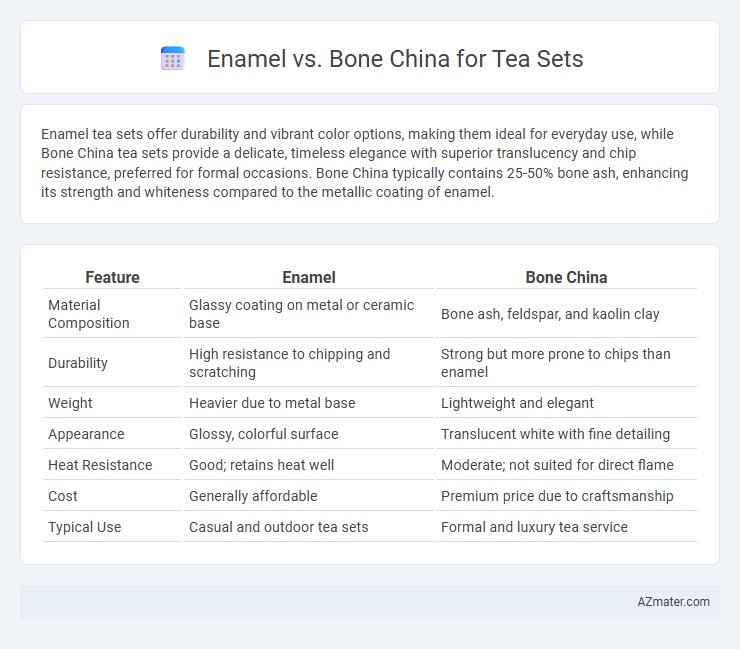Enamel tea sets offer durability and vibrant color options, making them ideal for everyday use, while Bone China tea sets provide a delicate, timeless elegance with superior translucency and chip resistance, preferred for formal occasions. Bone China typically contains 25-50% bone ash, enhancing its strength and whiteness compared to the metallic coating of enamel.
Table of Comparison
| Feature | Enamel | Bone China |
|---|---|---|
| Material Composition | Glassy coating on metal or ceramic base | Bone ash, feldspar, and kaolin clay |
| Durability | High resistance to chipping and scratching | Strong but more prone to chips than enamel |
| Weight | Heavier due to metal base | Lightweight and elegant |
| Appearance | Glossy, colorful surface | Translucent white with fine detailing |
| Heat Resistance | Good; retains heat well | Moderate; not suited for direct flame |
| Cost | Generally affordable | Premium price due to craftsmanship |
| Typical Use | Casual and outdoor tea sets | Formal and luxury tea service |
Introduction: Choosing Between Enamel and Bone China
Enamel tea sets offer durable, chip-resistant surfaces with vibrant colors ideal for everyday use, while bone china provides delicate elegance with translucent whiteness and refined craftsmanship suited for formal occasions. Enamel's sturdiness resists heat and scratches, making it highly practical, whereas bone china boasts superior whiteness, lightness, and a slightly translucent quality symbolizing luxury. Selecting between enamel and bone china depends on whether durability or sophistication aligns more with the tea set's intended purpose and aesthetic preference.
Material Composition: Enamel vs Bone China
Enamel tea sets feature a steel base coated with a smooth, durable layer of vitreous enamel, offering resistance to heat and chipping while being lightweight and affordable. Bone china is composed of bone ash, feldspathic material, and kaolin, resulting in a translucent, strong, and highly durable porcelain known for its refined appearance and chip resistance. The key difference lies in enamel's metal foundation with a glassy coated surface versus bone china's mineral-rich, fired ceramic body, influencing durability, weight, and aesthetics in tea sets.
Durability and Strength Comparison
Enamel tea sets are known for their exceptional durability thanks to their metal core coated with a porcelain-like finish, making them resistant to chipping and cracking under everyday use. Bone china tea sets, while more fragile, offer impressive strength relative to other ceramics due to their high calcium phosphate content, but they require careful handling to avoid damage. When comparing longevity, enamel tea sets often outperform bone china in resistance to impact and thermal shock, making them ideal for both indoor and outdoor use.
Heat Retention and Tea Experience
Bone china offers superior heat retention compared to enamel, ensuring tea stays warm longer due to its denser composition and fine porcelain glaze. Enamel tea sets, often made from metal coated with enamel, cool more quickly but provide a distinct vintage aesthetic and durability. The choice impacts the tea experience: bone china enhances flavor preservation and warmth, while enamel offers a more robust, nostalgic feel with faster heat dissipation.
Design Possibilities and Aesthetic Appeal
Enamel tea sets offer vibrant color options and durable finishes, allowing for bold, glossy designs that resist chipping and maintain a contemporary aesthetic. Bone china tea sets exude elegance with their translucent, delicate appearance and intricate patterns, often incorporating traditional motifs that enhance refinement and sophistication. Both materials provide unique design possibilities, with enamel favoring modern and eclectic styles, while bone china appeals to classic and ornate tastes.
Weight and Handling Comfort
Enamel tea sets are generally lighter due to their metal core coated with enamel, offering easier handling and better portability for daily use or outdoor settings. Bone china tends to be heavier and more delicate, providing a luxurious feel but requiring careful handling to avoid chipping or breakage. The weight difference significantly impacts comfort, with enamel favored for practicality and bone china preferred for formal occasions where elegance is prioritized.
Maintenance and Cleaning Requirements
Enamel tea sets require gentle hand washing with mild detergents to prevent chipping or discoloration, while bone china is dishwasher-safe but benefits from delicate cycles and non-abrasive cleaners to maintain its glaze and intricate patterns. Enamel can withstand higher temperatures but should be dried thoroughly to avoid rust on metal components, whereas bone china demands careful handling to prevent cracks and chipping due to its finer, more fragile composition. Maintaining enamel involves periodic seasoning or avoiding acidic substances, while bone china requires storing with padding to protect against impact and temperature extremes.
Price Range and Affordability
Enamel tea sets typically range from $20 to $60, offering an affordable option with durable, chip-resistant qualities ideal for everyday use. Bone china tea sets, often priced between $100 and $300, provide a luxurious, delicate design with superior translucency but require careful handling due to their fragility. Choosing between enamel and bone china depends largely on budget constraints and the intended use, with enamel catering to cost-effective practicality and bone china to elegant, high-end presentation.
Eco-Friendliness and Sustainability
Enamel tea sets are highly eco-friendly due to their durability, recyclability, and lower energy consumption during production, making them a sustainable choice for environmentally conscious consumers. Bone china, while elegant and lightweight, involves higher resource use and animal bone ash, raising concerns about sustainability and ethical sourcing. Opting for enamel promotes reduced environmental impact and a longer product lifecycle, aligning with green living values.
Conclusion: Best Tea Set Material for Your Needs
Enamel tea sets offer exceptional durability, vibrant colors, and affordability, making them ideal for casual, everyday use. Bone china provides a delicate, lightweight design with superior translucency and elegance suited for formal occasions or collectors. Choosing between enamel and bone china depends on whether you prioritize practicality and resilience or refined aesthetics and tradition in your tea set.

Infographic: Enamel vs Bone China for Tea Set
 azmater.com
azmater.com